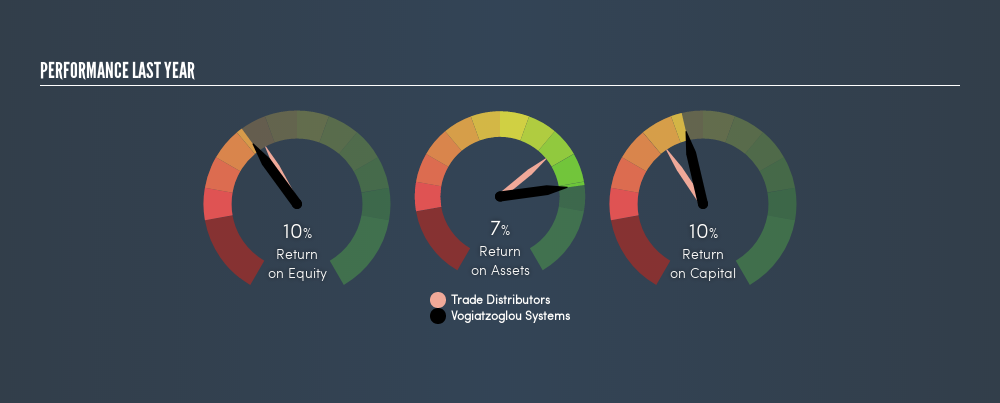- Greece
- /
- Trade Distributors
- /
- ATSE:VOSYS
What We Think Of Vogiatzoglou Systems S.A.’s (ATH:VOSYS) Investment Potential

Today we are going to look at Vogiatzoglou Systems S.A. (ATH:VOSYS) to see whether it might be an attractive investment prospect. Specifically, we'll consider its Return On Capital Employed (ROCE), since that will give us an insight into how efficiently the business can generate profits from the capital it requires.
First up, we'll look at what ROCE is and how we calculate it. Then we'll compare its ROCE to similar companies. And finally, we'll look at how its current liabilities are impacting its ROCE.
What is Return On Capital Employed (ROCE)?
ROCE is a metric for evaluating how much pre-tax income (in percentage terms) a company earns on the capital invested in its business. All else being equal, a better business will have a higher ROCE. Ultimately, it is a useful but imperfect metric. Renowned investment researcher Michael Mauboussin has suggested that a high ROCE can indicate that 'one dollar invested in the company generates value of more than one dollar'.
So, How Do We Calculate ROCE?
Analysts use this formula to calculate return on capital employed:
Return on Capital Employed = Earnings Before Interest and Tax (EBIT) ÷ (Total Assets - Current Liabilities)
Or for Vogiatzoglou Systems:
0.10 = €1.7m ÷ (€23m - €6.8m) (Based on the trailing twelve months to June 2018.)
Therefore, Vogiatzoglou Systems has an ROCE of 10%.
See our latest analysis for Vogiatzoglou Systems
Does Vogiatzoglou Systems Have A Good ROCE?
ROCE is commonly used for comparing the performance of similar businesses. Using our data, Vogiatzoglou Systems's ROCE appears to be around the 11% average of the Trade Distributors industry. Setting aside the industry comparison for now, Vogiatzoglou Systems's ROCE is mediocre in absolute terms, considering the risk of investing in stocks versus the safety of a bank account. Investors may wish to consider higher-performing investments.
Our data shows that Vogiatzoglou Systems currently has an ROCE of 10%, compared to its ROCE of 7.9% 3 years ago. This makes us wonder if the company is improving.

Remember that this metric is backwards looking - it shows what has happened in the past, and does not accurately predict the future. ROCE can be deceptive for cyclical businesses, as returns can look incredible in boom times, and terribly low in downturns. ROCE is, after all, simply a snap shot of a single year. How cyclical is Vogiatzoglou Systems? You can see for yourself by looking at this freegraph of past earnings, revenue and cash flow.
Vogiatzoglou Systems's Current Liabilities And Their Impact On Its ROCE
Short term (or current) liabilities, are things like supplier invoices, overdrafts, or tax bills that need to be paid within 12 months. The ROCE equation subtracts current liabilities from capital employed, so a company with a lot of current liabilities appears to have less capital employed, and a higher ROCE than otherwise. To check the impact of this, we calculate if a company has high current liabilities relative to its total assets.
Vogiatzoglou Systems has total assets of €23m and current liabilities of €6.8m. As a result, its current liabilities are equal to approximately 29% of its total assets. This very reasonable level of current liabilities would not boost the ROCE by much.
The Bottom Line On Vogiatzoglou Systems's ROCE
If Vogiatzoglou Systems continues to earn an uninspiring ROCE, there may be better places to invest. You might be able to find a better investment than Vogiatzoglou Systems. If you want a selection of possible winners, check out this freelist of interesting companies that trade on a P/E below 20 (but have proven they can grow earnings).
I will like Vogiatzoglou Systems better if I see some big insider buys. While we wait, check out this freelist of growing companies with considerable, recent, insider buying.
We aim to bring you long-term focused research analysis driven by fundamental data. Note that our analysis may not factor in the latest price-sensitive company announcements or qualitative material.
If you spot an error that warrants correction, please contact the editor at editorial-team@simplywallst.com. This article by Simply Wall St is general in nature. It does not constitute a recommendation to buy or sell any stock, and does not take account of your objectives, or your financial situation. Simply Wall St has no position in the stocks mentioned. Thank you for reading.
About ATSE:VOSYS
Vogiatzoglou Systems
Provides furnishing equipment solutions for retail stores, warehouses, and distribution centers in Greece.
Moderate second-rate dividend payer.
Market Insights
Community Narratives





